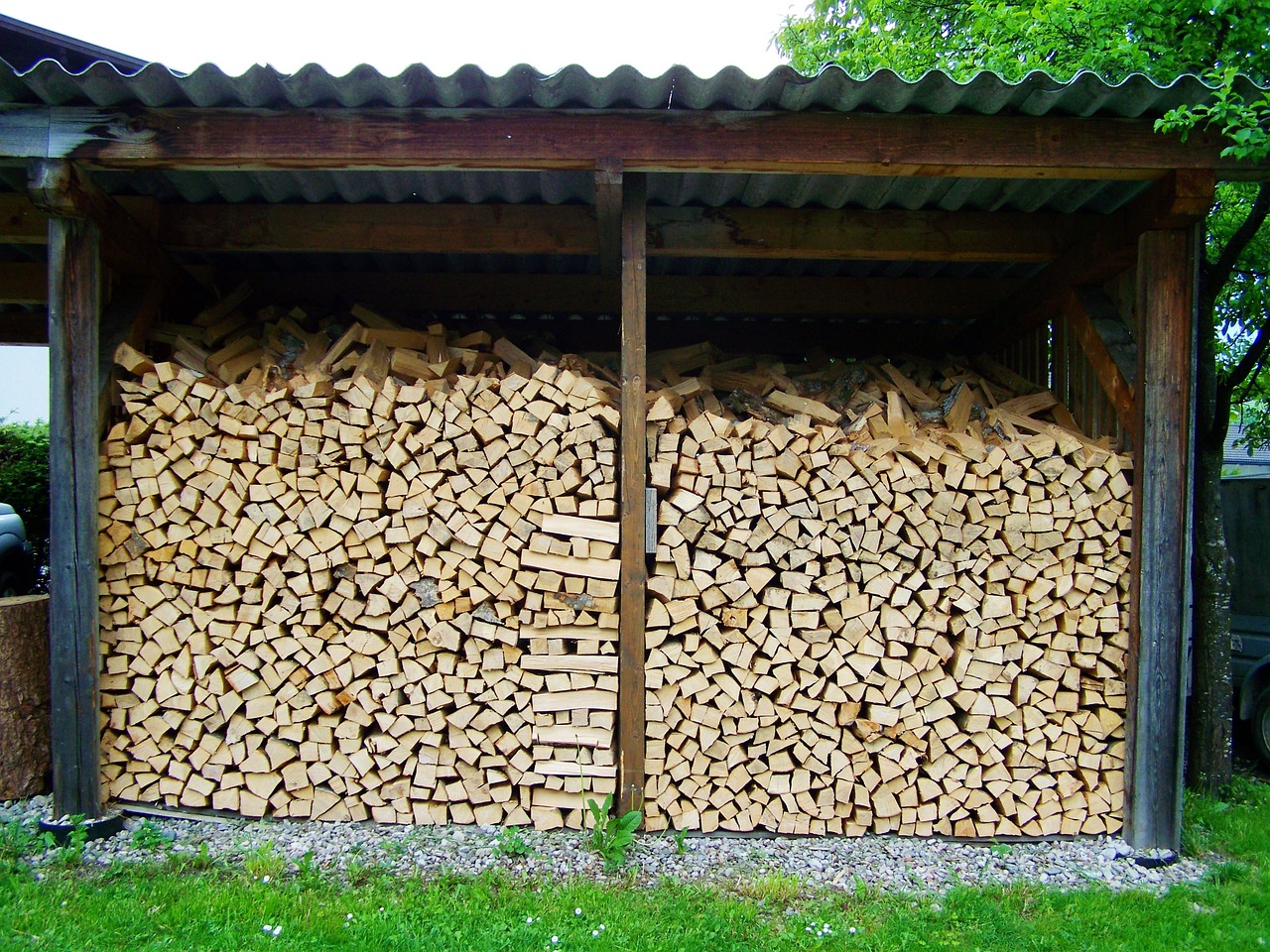As the crisp autumn air settles in and winter approaches, the allure of a warm, crackling fire becomes irresistible. Whether you rely on a wood-burning stove, fireplace, or outdoor fire pit, the key to a successful and enjoyable experience lies in proper firewood storage. In this comprehensive guide, we’ll dig into the intricacies of firewood storage, covering everything from selecting the right wood to constructing effective storage solutions.
Choosing the Right Firewood
Before we dive into the intricacies of storage, let’s first explore the importance of selecting the right type of firewood. Not all wood is created equal, and understanding the characteristics of different types will significantly impact your fire’s performance.
Hardwood vs. Softwood
Hardwoods, such as oak, maple, and hickory, burn slower and produce more sustained heat compared to softwoods like pine and spruce. Softwoods, however, ignite more quickly, making them ideal for kindling.
Moisture Content:
The moisture content of firewood is critical. Well-seasoned wood, with a moisture content below 20%, burns cleaner and more efficiently. Invest in a moisture meter to ensure your wood is adequately seasoned.
Size Matters
Cut your firewood to the appropriate length for your fireplace or stove. Standard lengths range from 14 to 20 inches. Split larger logs for quicker drying and more efficient burning.
The Art of Seasoning Firewood
Properly seasoned firewood is the foundation of a successful fire. Seasoning, or drying, is the process of reducing the moisture content in wood. This not only ensures a cleaner burn but also prevents the build-up of creosote in your chimney.
Air Drying
The most common method of seasoning is air drying. Stack split wood in a location with good air circulation, preferably off the ground. Cover the top to protect against rain while allowing the sides to remain open for ventilation.
Stacking Techniques
Consider different stacking techniques, such as the crisscross or holzhausen method, to maximize airflow. Properly stacked wood dries more evenly and quickly.
Patience Pays Off
Seasoning takes time, typically six months to a year, depending on the type of wood and local climate. Avoid burning freshly cut wood, as it produces less heat and more smoke.
Creating an Ideal Storage Space
Now that you have carefully chosen and seasoned your firewood, it’s time to focus on creating an ideal storage space. A well-designed storage area protects your investment and ensures a steady supply of quality firewood.
Location Matters
Choose a dry and well-ventilated location for your storage area. Avoid placing it directly against a building to prevent moisture accumulation. Elevated platforms or pallets can help keep wood off the ground.
Covering Your Stash
While seasoned wood is less prone to moisture absorption, covering your firewood with a tarp or roof still provides an extra layer of protection. Ensure the cover allows for proper ventilation to prevent mold growth.
Consideration for Indoor Storage
If you’re storing firewood indoors, select a spot with good airflow to prevent musty smells. Keep the wood at least 2 feet away from heat sources to reduce the risk of insect infestations.
Building Firewood Racks and Sheds
Now, let’s explore various options for constructing firewood storage solutions. From simple racks to more elaborate sheds, there’s a design to suit every need and aesthetic.
Basic Firewood Rack
A basic firewood rack is a cost-effective and straightforward solution. It consists of a frame with open sides, allowing for easy access and good airflow. Elevate it slightly to prevent ground moisture.
Covered Firewood Rack
Enhance the basic rack by adding a roof or cover. This protects the wood from rain and snow, ensuring it stays dry and ready for use. A covered rack is an excellent compromise between simplicity and added protection.
Holzhausen or Round Stack
The holzhausen method involves stacking wood in a circular pattern, creating a self-supporting structure. This ancient European technique not only looks aesthetically pleasing but also maximizes air circulation.
Firewood Shed
For those with larger quantities of firewood, a dedicated shed provides maximum protection. With walls on three sides and a roof, it shields wood from the elements while offering ample storage space. Include vents for proper ventilation.
Maintaining Firewood Quality
Your commitment to firewood storage doesn’t end once the wood is stacked neatly in its designated space. Regular maintenance ensures that your firewood remains in top condition, ready to provide warmth and ambiance whenever needed.
Rotating Stock
Practice the “first in, first out” principle. Use the oldest wood first to prevent it from becoming over-seasoned or potentially rotting. This rotation ensures a steady supply of well-seasoned firewood.
Pest Control
Inspect your firewood regularly for signs of pests like termites or ants. Elevating the wood and keeping the storage area clean reduces the risk of infestations. If pests are detected, address the issue promptly.
Regular Checks
Periodically check for signs of mold or mildew. If you notice any, remove affected pieces and allow the rest to breathe. Adequate ventilation is crucial in preventing the growth of these unwanted guests.
Troubleshooting Common Issues
Even with the best intentions and efforts, issues can arise. Let’s explore common problems related to firewood storage and how to address them effectively.
Mold and Mildew
If mold or mildew appears, increase airflow by reorganizing the stack and removing affected pieces. Consider moving the storage location to a drier area or using a dehumidifier for indoor storage.
Insect Infestations
If insects become a problem, consider treating the wood with a natural insect repellent or moving to a different storage location. Regular inspections are key to catching infestations early.
Excessive Moisture
In areas with high humidity, it may be challenging to keep firewood completely dry. Using a dehumidifier for indoor storage or investing in moisture-resistant covers for outdoor stacks can help mitigate this issue.
Sustainability in Firewood Usage
As we enjoy the warmth and comfort of a crackling fire, it’s essential to consider the environmental impact of our wood-burning practices. Adopting sustainable habits ensures that future generations can also benefit from this timeless tradition.
Responsible Harvesting
Source firewood from sustainable and well-managed forests. Avoid cutting down trees in protected areas or those that serve as habitats for endangered species. Respect local regulations and guidelines.
Efficient Burning Practices
Maximize the efficiency of your wood-burning appliance by using dry, well-seasoned wood. This not only reduces emissions but also prolongs the lifespan of your equipment.
Exploring Alternative Fuels
Consider alternative heating sources, such as pellet stoves or wood bricks made from compressed sawdust. These options often burn more efficiently and have a lower environmental impact.
Conclusion
Mastering the art of firewood storage is a journey that begins with selecting the right wood and ends with a warm, inviting fire on a cold winter’s night. By understanding the nuances of wood selection, seasoning, storage, and maintenance, you not only ensure a reliable source of heat but also contribute to a sustainable and eco-friendly approach to enjoying this timeless tradition. With the knowledge gained from this comprehensive guide, you’re well-equipped to embark on a firewood storage adventure that will keep you warm and cozy for years to come.





